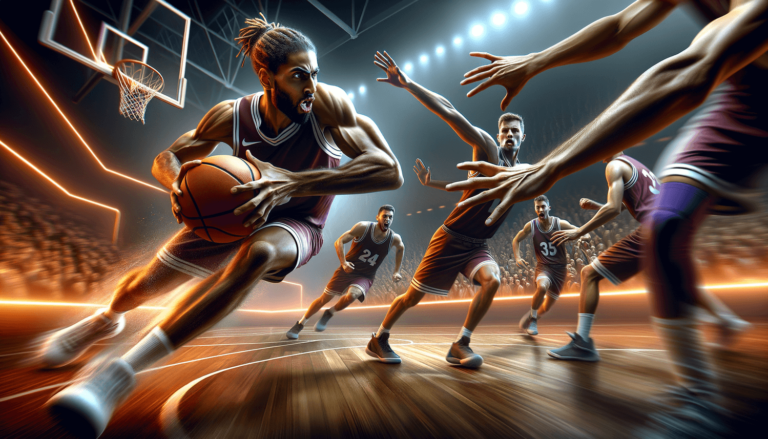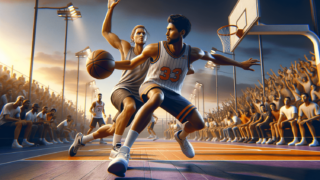
Picture this: you’re on the court, heart pounding, sneakers squeaking, and suddenly there’s a split-second decision to be made that might just be the game changer. Welcome to the world of closeouts in basketball. What was once just a technical term known by dedicated insiders has recently seen a surge in public interest. So, what exactly is a closeout? Whether you’re a seasoned pro or a curious newbie, grab a seat and join us as we dive into the ins and outs of this critical defensive tactic that can mean the difference between victory and defeat.
What’s a Closeout in Basketball?
A closeout in basketball is a defensive maneuver used by a player to quickly transition from help defense to guarding their opponent who has just received the ball. This action involves sprinting towards the offensive player while maintaining balance and control, effectively challenging the opponent’s potential shot, pass, or drive to the basket. Done correctly, a closeout can disrupt the offense’s rhythm and force them into taking a more difficult shot or making a mistake.
The Importance of a Closeout in Basketball
In the high-stakes world of basketball, every possession counts. One of the most overlooked yet crucial aspects of the game is a player’s ability to execute a proper closeout. Elite defenders understand that mastering this skill is essential for limiting the opponent’s efficiency on offense. The closeout directly impacts shot contests, defensive rotations, and overall communication on the court. Let’s break down the fundamentals of closeouts and explore how players can improve their closeout technique to become more effective defenders on the basketball court.
Breaking Down the Fundamentals of a Closeout
1. Quick Decision-Making and Anticipation
A successful closeout starts with the mental aspect of the game. As a defender, being able to read and react to the offensive player’s actions is crucial. This means closely watching the passer and anticipating when and where the ball will be delivered. Quick decision-making can be the difference between contesting a shot or being late to the party.
2. Controlled Sprint and Explosiveness
Once the defender has anticipated the pass, it’s time to use their athleticism to sprint towards the intended receiver. This should be a controlled explosion, maintaining balance and ensuring that the defender doesn’t over-commit or lose momentum. Shuffling and changing direction quickly are essential to keep the offensive player under constant pressure.
3. Proper Closeout Stance and Technique
Upon reaching the offensive player, the defender should land in a balanced stance with their hands high, closing out the passing and shooting lanes. It’s essential to maintain a low and wide stance throughout the process, maximizing lateral movement capacity and allowing the defender to quickly react to the offensive player’s next move.
4. Know Your Opponent
Each closeout should be tailored to the specific opponent. Knowing the tendencies and strengths of the offensive player is key to executing the correct closeout. Are they a knock-down three-point shooter? If so, focus on closing out the shooting lane aggressively. If they’re a crafty driver with a quick first step, ensure you strike a balance between contesting the shot and preventing the drive.
Drills to Improve Your Closeout
Like anything in basketball, deliberate practice is the key to mastering the art of the closeout. Below are some drills that players and coaches can use to improve this critical defensive skill:
1. Zigzag Closeout Drill
This drill helps players practice their controlled sprints, change of direction, and defensive stance. Set up cones or markers in a zigzag pattern down the court. Have the defender sprint toward each cone with an explosive first step, decelerate and change direction while maintaining a low and wide stance upon reaching each marker. Perform this drill at game speed for maximum benefit.
2. Help-to-Closeout Drill
This drill challenges players to quickly transition from help defense to an on-ball closeout. Set up two offensive players on the weak side of the court, with one positioned on the wing and the other on the corner three-point line. The defender starts in the paint in a help position, ideally splitting the two offensive players. The coach will pass the ball to either offensive player. The defender must close out on the ball, contesting a shot or drive, before quickly recovering back to the paint to resume their help defense position.
3. Closeout and Recovery Drill
This drill focuses on closeouts, communicating, and recovering. Place two offensive players on the same side of the court, one in the corner and the other on the wing. The defensive player starts at the top of the key, sprinting to close out on the player in the corner. The offensive player passes to the wing, forcing the defender to sprint and close out on the new ball-handler. Repeat this drill to practice closing out effectively and communication between teammates for greater defensive awareness.
Closeout Challenges and Attacking Countermoves
1. Shot Fakes and Pump Fakes
Offensive players can use shot fakes to catch an over-aggressive defender off guard. If the defender bites on the fake, the offensive player can drive past, initiating a dish or a drive and kick opportunity. It’s crucial for defenders to stay disciplined during closeouts, keeping their feet on the ground and reacting to the offensive player’s actions rather than their intentions.
2. Quick Releases and Stepbacks
Sharpshooters with quick releases present unique challenges for defenders during closeouts. Being ready to contest the shot without compromising the defensive stance is essential. Offensively, a stepback move can create space between the defender, opening up shooting opportunities. Defenders should be ready to contest this as well by maintaining a balanced and low stance throughout the closeout.
3. Drives and Counter Drives
If a defender over-commits to the closeout, a quick, crafty offensive player can exploit the situation with a hard drive to the basket. As a defender, it’s essential to time the closeout correctly and maintain a proper stance to prevent giving up a straight-line drive. For offensive juggernauts, making use of the change of pace can deceive defenders and create scoring opportunities on counter drives.
Closeout Tips for Different Player Types
1. Perimeter Shooters
When closing out on lethal perimeter shooters, the defender should focus on taking away their shot first and foremost. Close out with high hands, ensuring that the shooter feels pressure when attempting a shot. The defender’s top foot should point towards the sideline, allowing them to contest the drive if the offensive player decides to attack the basket.
2. Slashers
Closing out on slashers, or players known for driving to the basket, requires a slightly different approach. The defender must still close out with high hands; however, the emphasis should be on keeping the top foot higher than when defending a perimeter shooter, allowing for a quicker response to potential drives and quick first steps towards the basket.
3. Versatile Scoring Threats
An offensive player who poses equal danger from the outside and inside requires a disciplined approach on defense. The key to defending versatile scoring threats is striking a balance between taking away their shooting and driving capabilities.
Closeout Success Stories in Basketball History
Throughout basketball history, several game-changing closeouts have shown the importance of honing this defensive skill. From Kawhi Leonard’s incredible block on James Harden in the 2017 NBA regular season to LeBron James’ chase down block on Andre Iguodala in the 2016 NBA Finals, these crucial closeouts have played a significant role in altering the outcome of games and, in some cases, entire playoff series. The mastery of closeouts can elevate the overall impact of a defender and, subsequently, their team’s chances of success.
Conclusion
Executing a successful closeout in basketball requires keen anticipation, controlled explosiveness, and the ability to maintain a balanced stance. Continual practice and refinement are essential to mastering this critical defensive skill. By understanding the fundamentals, practicing intelligently, and learning to adapt to various offensive threats, players can enhance their defensive prowess, propelling their teams towards success on the basketball court.
Common Closeout Mistakes and How to Avoid Them
Despite the importance of executing proper closeouts, basketball players at all levels still commit common mistakes that limit their effectiveness. By understanding and addressing these shortcomings in technique, players can drastically improve their defensive skills and contribute more positively to their team’s efforts.
1. Overcommitting on Closeouts
One of the most common mistakes made during closeouts is overcommitting, which leaves defenders vulnerable to counterattacks by the offensive player. Overcommitting typically results from sprinting too hard or taking a poor angle towards the offensive player, making it easy for them to drive past the off-balance defender. To avoid this, players should focus on sprinting with control and decelerating as they approach their opponent, maintaining balance throughout the closeout.
2. Leaning or Lunging at the Ball
Another common mistake occurs when the defender lunges or leans towards the ball, trying to swat or reach it. This compromises their stance, balance, and stability, making them susceptible to getting beaten off the dribble. To avoid this, players should maintain a balanced stance with their hands high throughout the closeout, placing their top foot slightly higher than the other to prevent a straight-line drive to the basket.
3. Failure to Communicate
Communication is essential during closeouts, as it aids in proper defensive rotations and overall defensive cohesion. Failing to communicate can lead to blown assignments, unnecessary double teams, or wide-open opponents. Players should communicate with their teammates about who they are closing out on and the type of closeout they intend to execute to reduce confusion and create a stronger defensive unit.
Importance of Team Closeout Tactics
Individual closeout technique is crucial; however, closeouts in basketball should be executed as part of a cohesive team strategy. The ideal closeout approach may vary depending on the specific defensive scheme and game situation. Through effective communication and cooperation, teams can create a more challenging environment for their opponents, ultimately resulting in increased defensive success.
1. Help and Recover
In this closeout tactic, a help defender rotates to stop the ball, then quickly recovers to their own player immediately after the ball-handler gets rid of it. Being able to help and recover effectively requires excellent communication among teammates, who need to be able to adjust their defensive assignments accordingly.
2. Rotations and Stunts
Defensive rotations and stunts involve defenders switching assignments temporarily to disrupt the offensive player’s rhythm before quickly returning to their original man. This tactic is particularly useful in scenarios when the defense is outnumbered or when the offensive team is running a fast-paced attack. Correctly executing these tactics requires precise timing and well-coordinated teamwork.
3. Trapping and Denial
Trapping and denial closeout tactics involve aggressive pressure on the ball-handler in an attempt to force turnovers or disrupt the offensive flow. In this scenario, help defenders take the risk of leaving their man temporarily to double-team the offensive player with the ball. The rest of the team must be prepared to rotate and close out on any open shooters, should the ball-handler manage to pass out of the trap.
Achieving Consistency in Closeout Execution
To become a consistent and reliable defender, players must strive to execute perfect closeouts, no matter the game situation or the level of offensive threat. Putting it all together—anticipating passes, sprinting under control, adopting the proper stance, and reacting quickly and efficiently to the offensive player’s decisions—will help players master the art of the closeout, thus elevating their overall defensive capabilities on the basketball court.
FAQ: Closeouts in Basketball
For those seeking to expand their understanding of closeouts in basketball, this FAQ section addresses some of the most common questions related to this essential defensive technique. Explore these questions and answers to gain greater insight into how closeouts work, their purpose in the game, and how they contribute to successful defensive strategies.
1. What is the purpose of a closeout?
The primary purpose of a closeout is to quickly transition from help defense to guarding an opponent who has just received the ball, pressuring them and limiting their scoring opportunities. An effective closeout challenges the offensive player’s potential shot, pass, or drive to the basket, disrupting their offensive rhythm.
2. How do you perform a proper closeout?
Performing a proper closeout involves anticipating the pass, sprinting rapidly yet controlled towards the offensive player, landing in a balanced stance with hands high, and maintaining a low, wide stance to prepare for the player’s next move. It is crucial to adapt the closeout to the specific opponent, accounting for their strengths and tendencies.
3. What are some common closeout mistakes?
Common closeout mistakes include overcommitting, lunging or leaning at the ball, and failing to communicate with teammates. Each of these mistakes can lead to defensive vulnerabilities and make it easier for the offensive player to create scoring opportunities.
4. How should a closeout be tailored based on the offensive player’s strengths?
When closing out on perimeter shooters, the focus should be on taking away their shot with high hands. For slashers, who are more likely to drive to the basket, the defender should maintain a proper stance and quick lateral movement to prevent penetration. When dealing with versatile scoring threats, it’s essential to strike a balance between taking away their shooting and driving capabilities.
5. How do closeout techniques vary in team defensive strategies?
Closeout techniques can be adjusted depending on specific team defensive strategies such as help and recover, rotations and stunts, and trapping and denial. Within these schemes, players may need to alter their closeout approach to better align with the team’s overall defensive goals.
6. Why is communication so essential during closeouts?
Effective communication during closeouts aids in proper defensive rotations, helps teammates adjust assignments, and ensures that players are aware of each other’s intentions when executing closeouts. Strong communication results in a more cohesive and challenging defensive unit.
7. How can coaches create drills to improve closeout skills?
Coaches can create closeout drills that focus on controlled sprinting, change of direction, maintaining proper defensive stances, quick decision-making, and adapting closeouts based on various offensive threats. Implementing drills that require teamwork and communication can also contribute to creating a stronger and more unified defense.
8. What is the role of closeouts in help defense scenarios?
In help defense scenarios, the closeout is crucial for quickly transitioning from a help position back to guarding the player’s assigned man after the ball changes hands. This quick recovery prevents the opposing team from exploiting the temporary defensive mismatch and ultimately limits their scoring opportunities.
9. How can players improve the anticipation aspect of closeouts?
Improving anticipation during closeouts requires closely watching the passer, understanding the offensive team’s patterns and plays, and being ready to react to the ball’s movement. Building awareness and familiarity with opponents also aids in developing quick anticipation skills.
10. What is the relationship between closeouts and overall defensive success?
Successful closeouts directly affect shot contests, defensive rotations, and on-court communication. As they limit the offensive player’s scoring opportunities and disrupt their rhythm, closeouts are instrumental in establishing a strong defense, ultimately contributing to a team’s overall success in basketball.
Featured Posts
- No pillar pages found.





